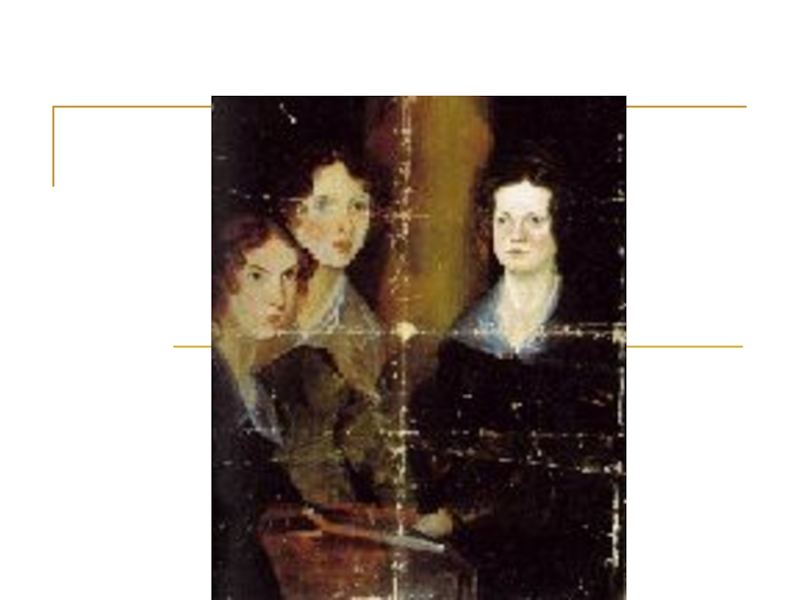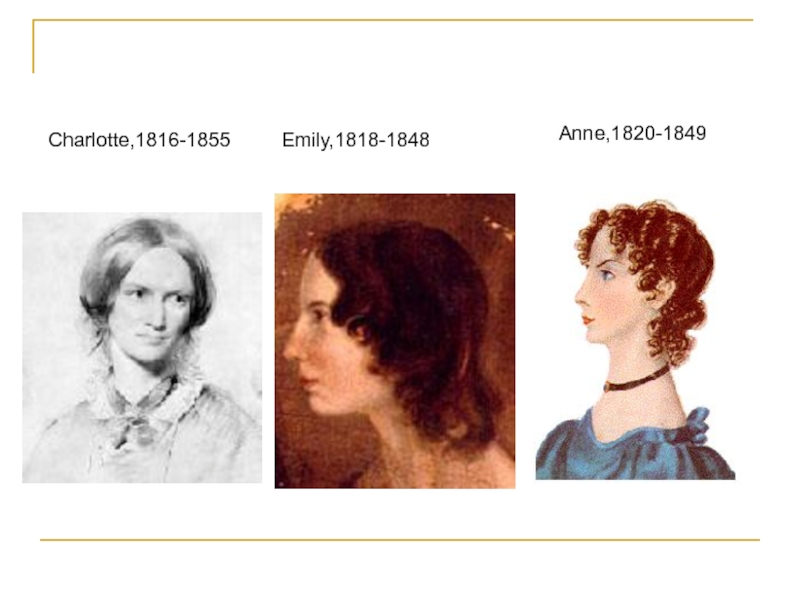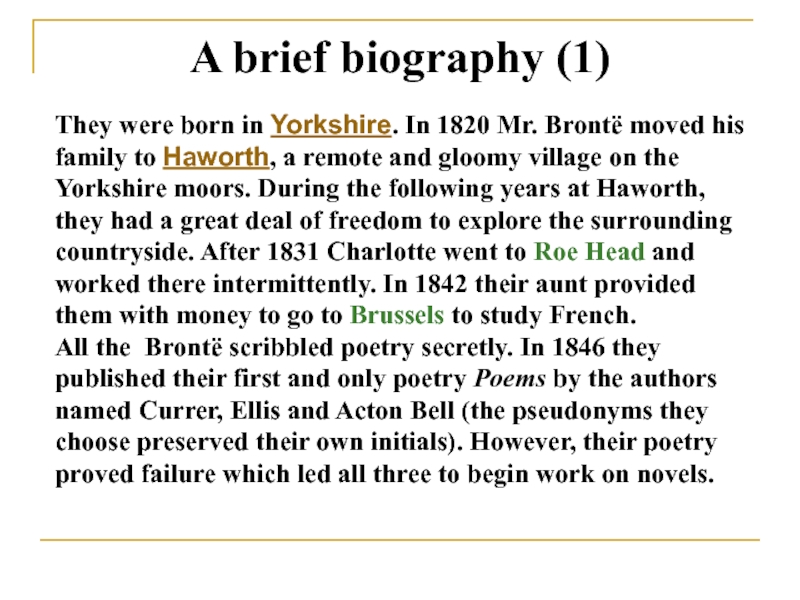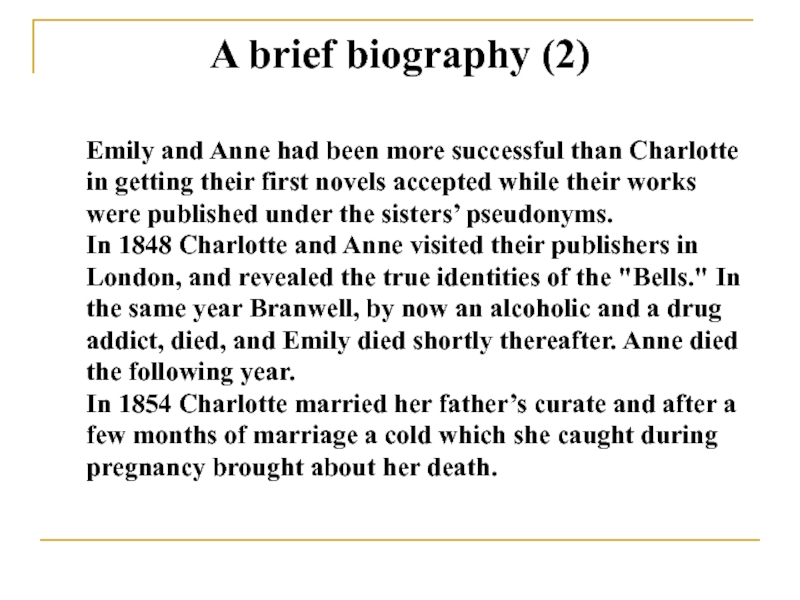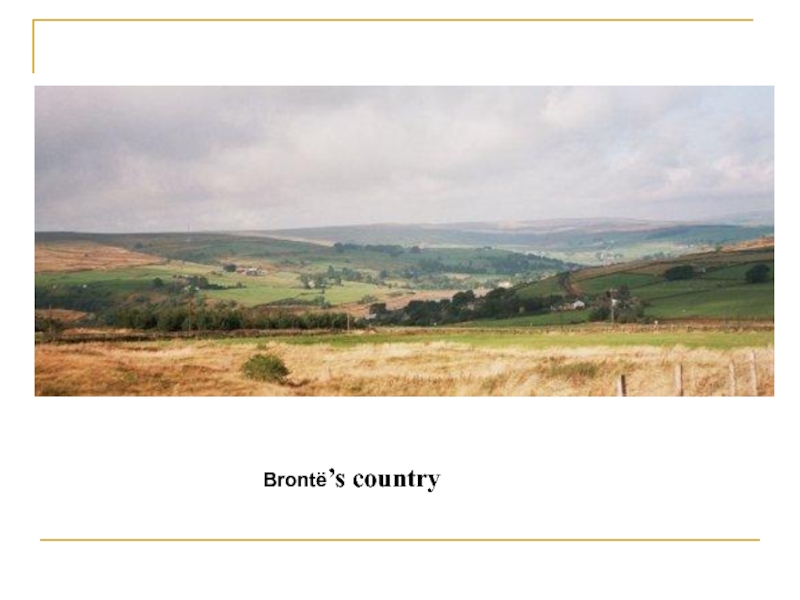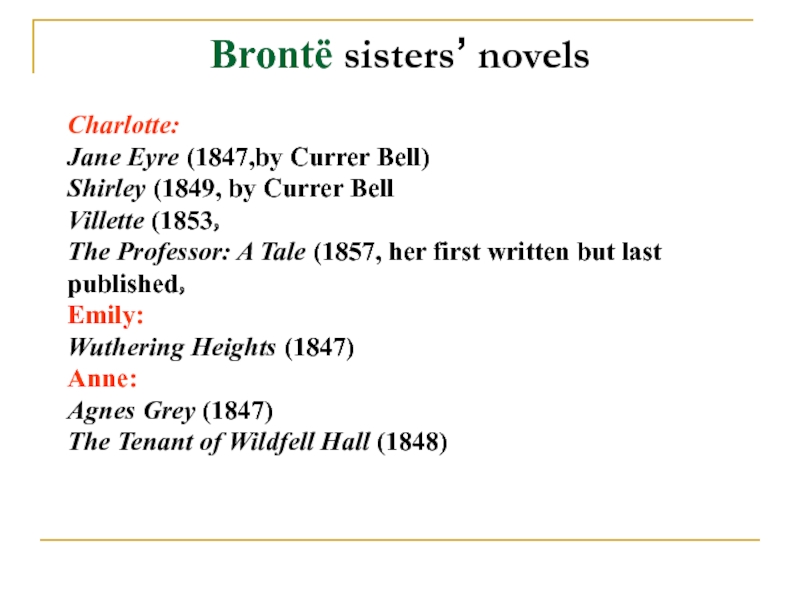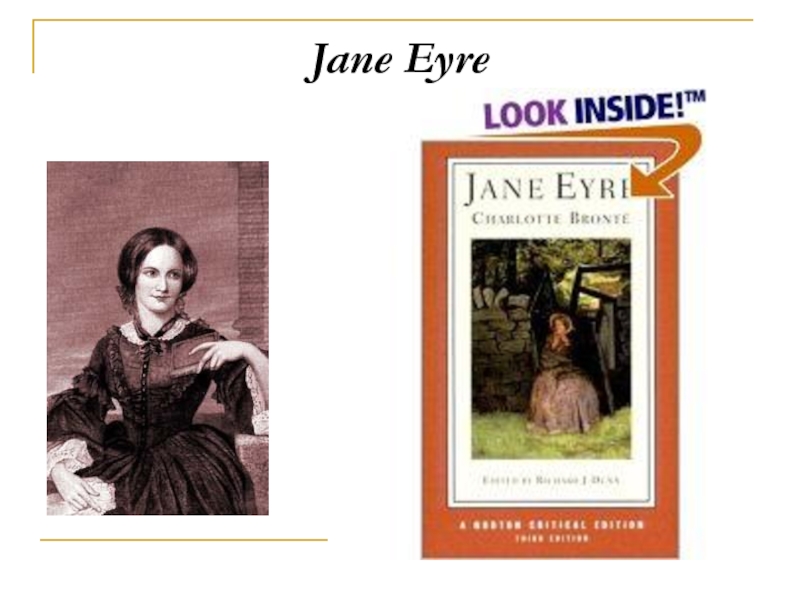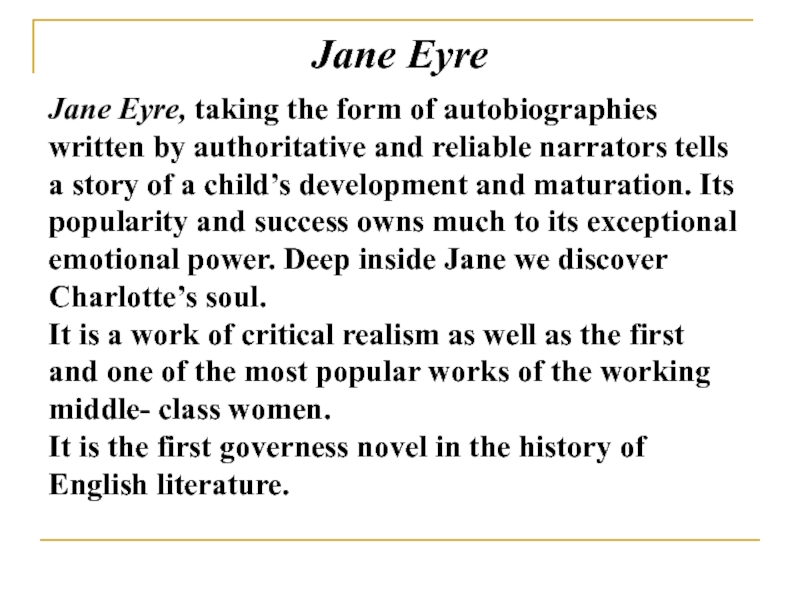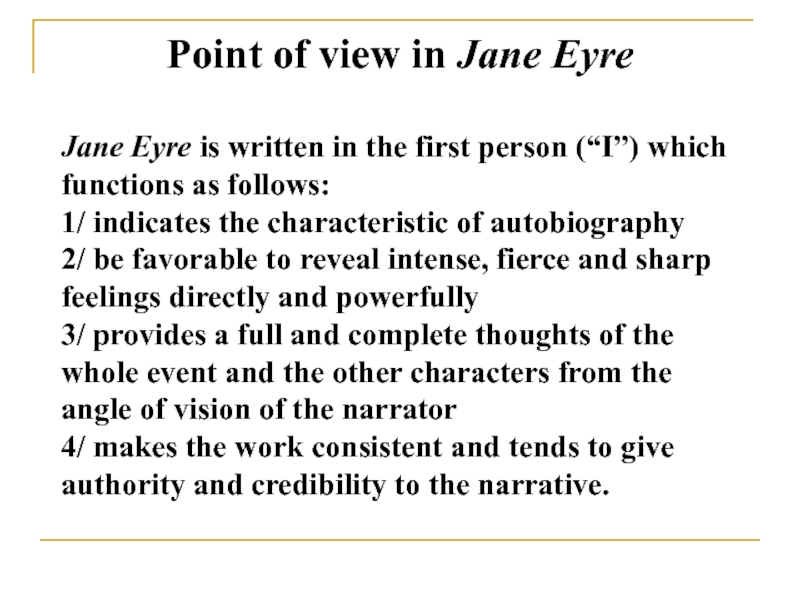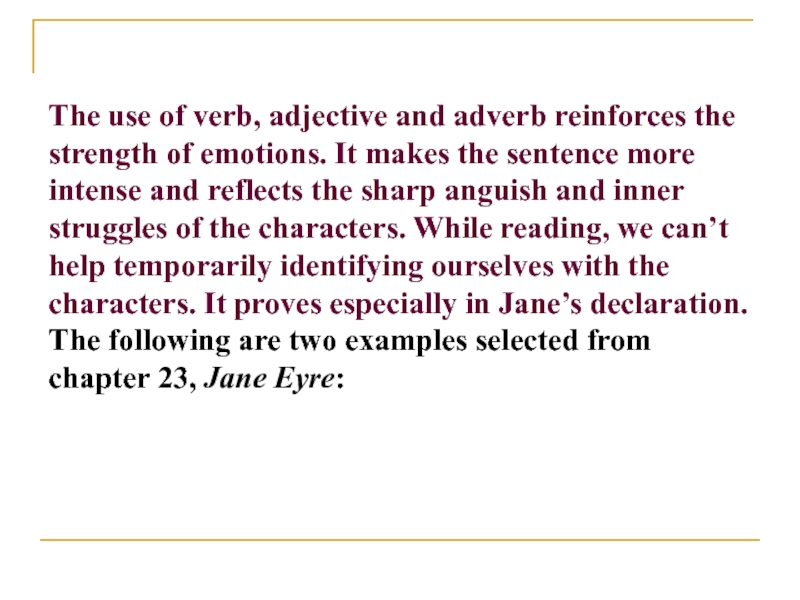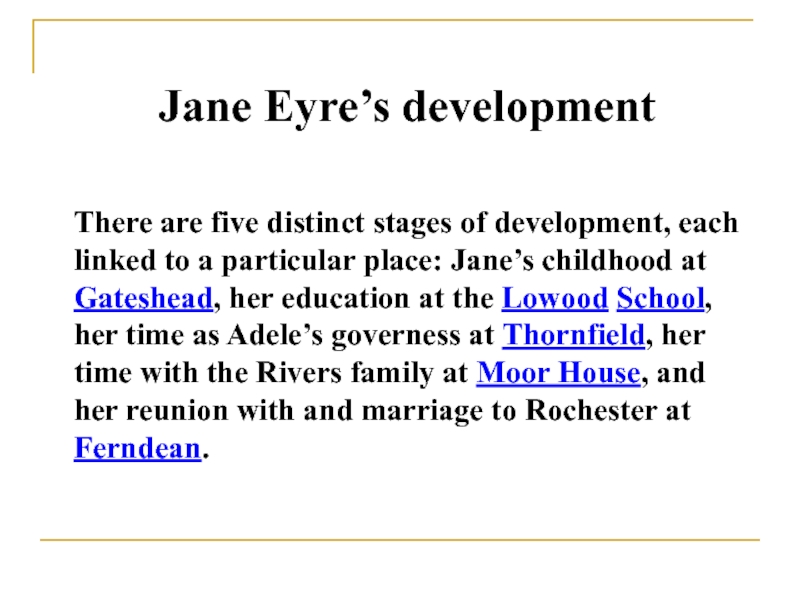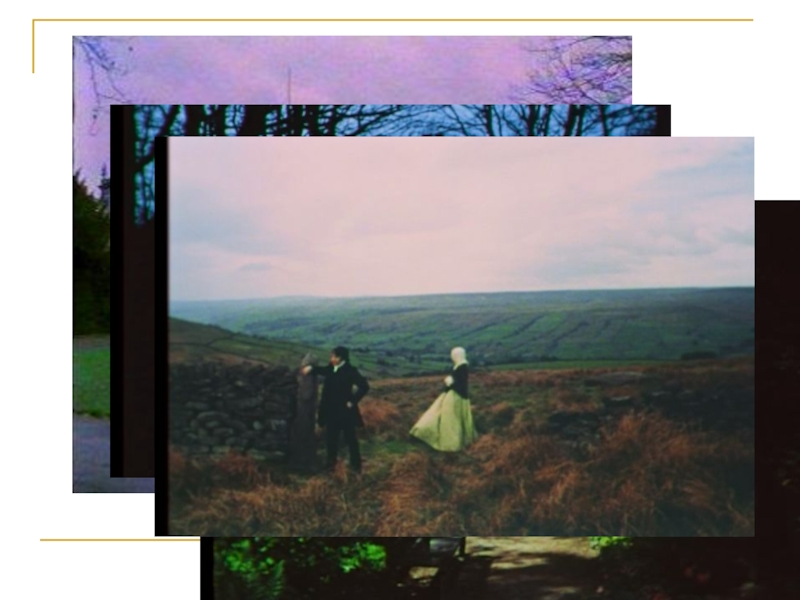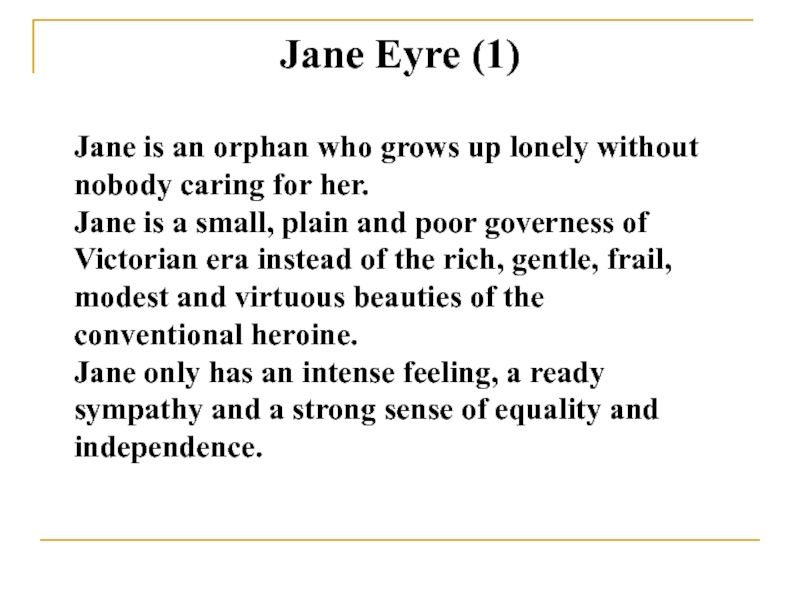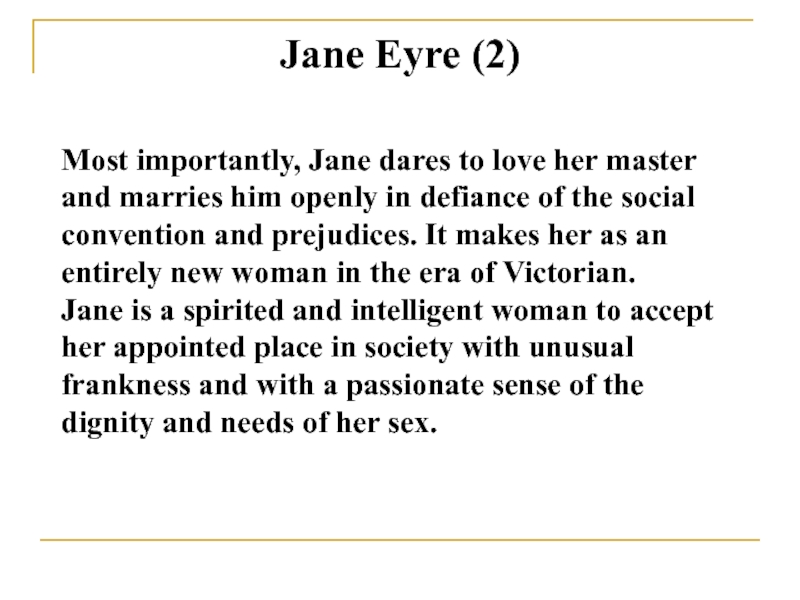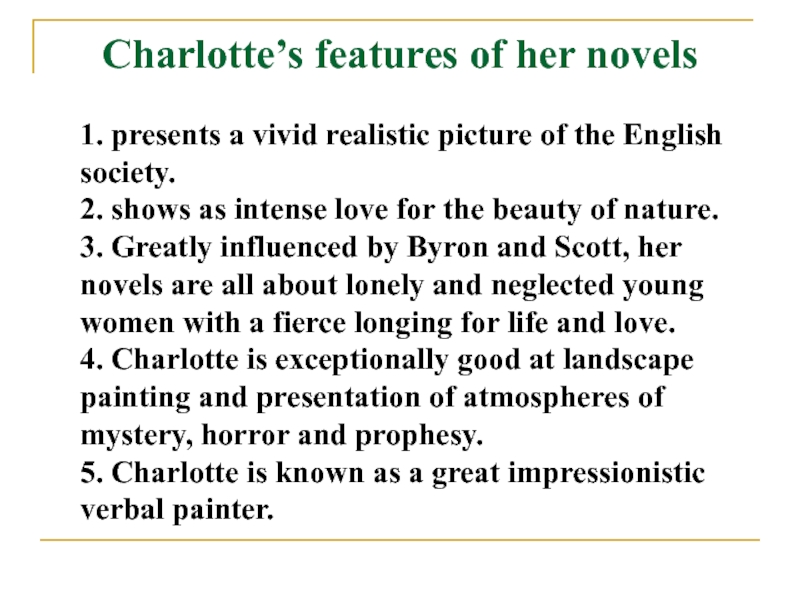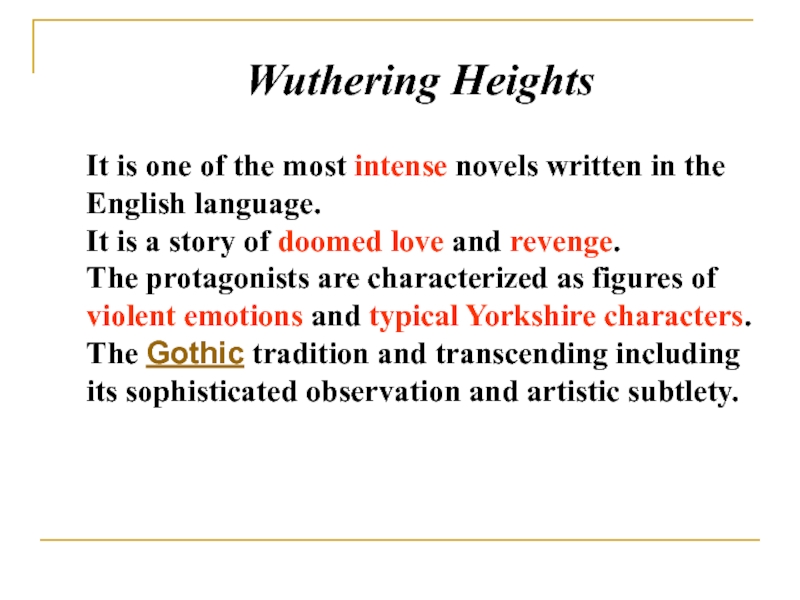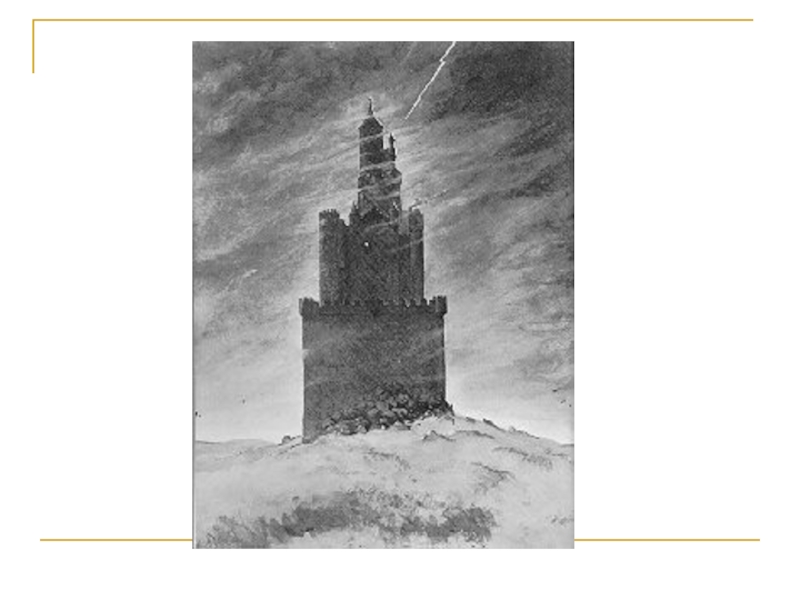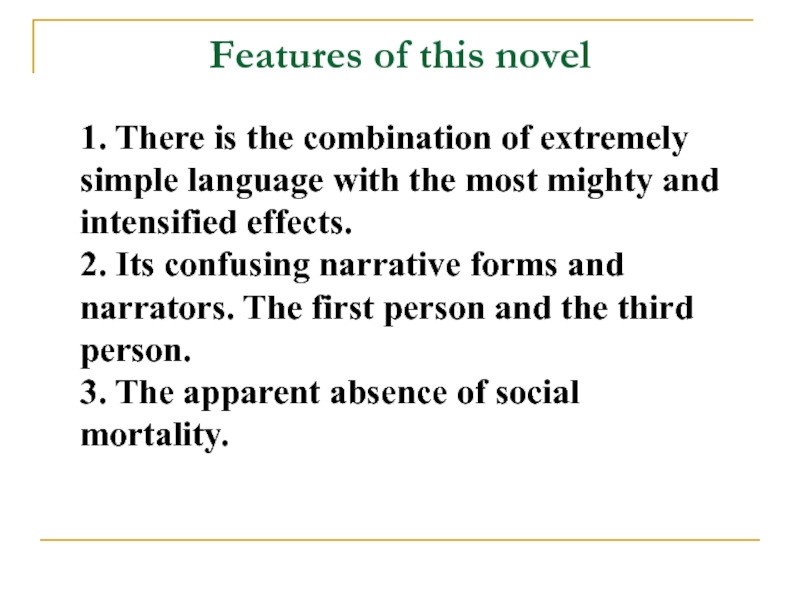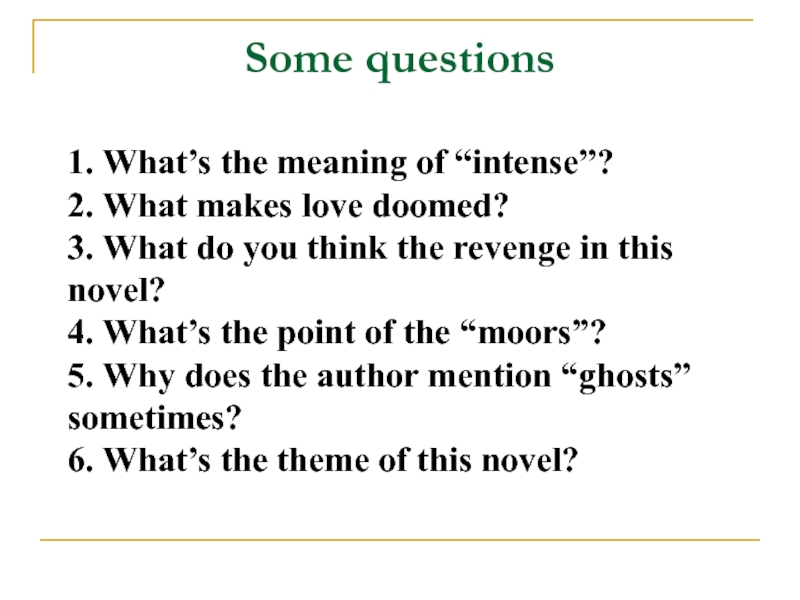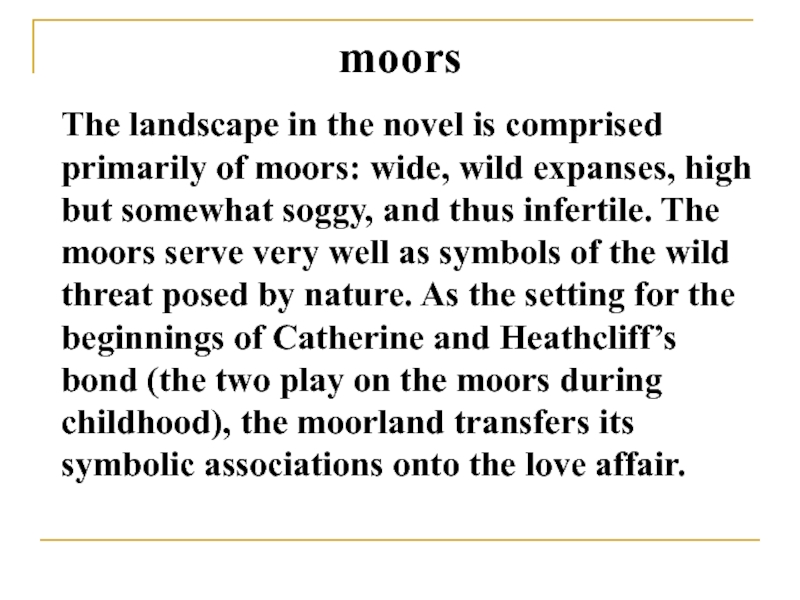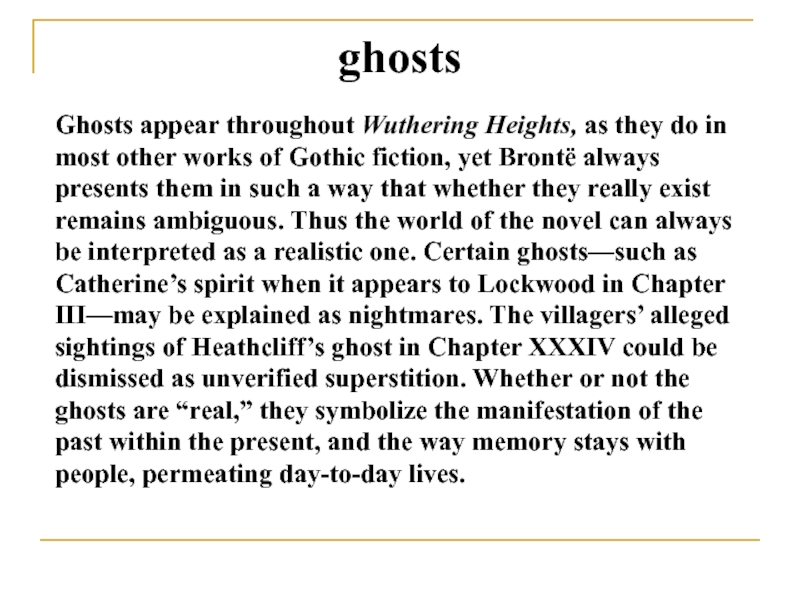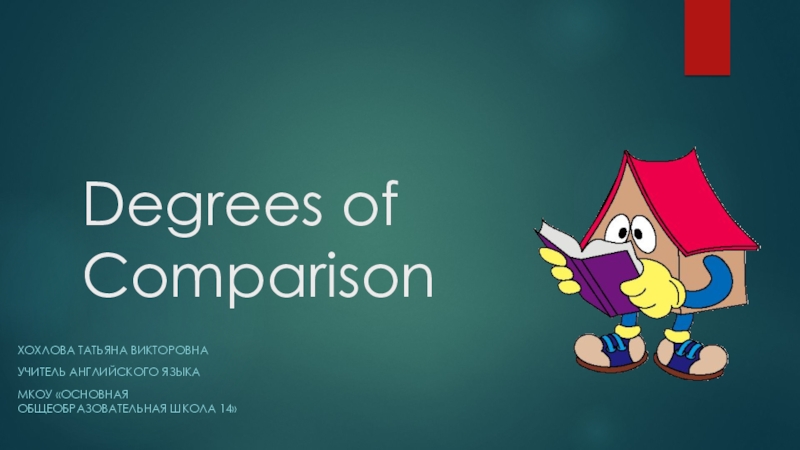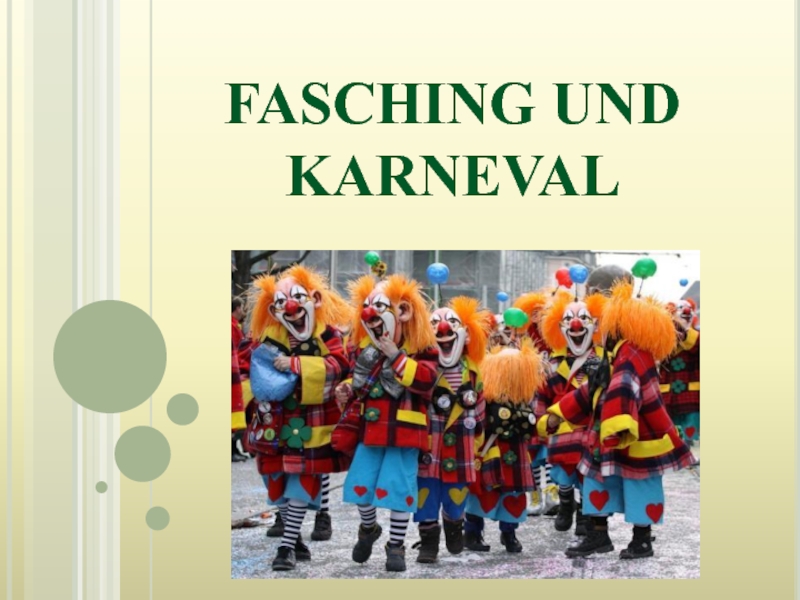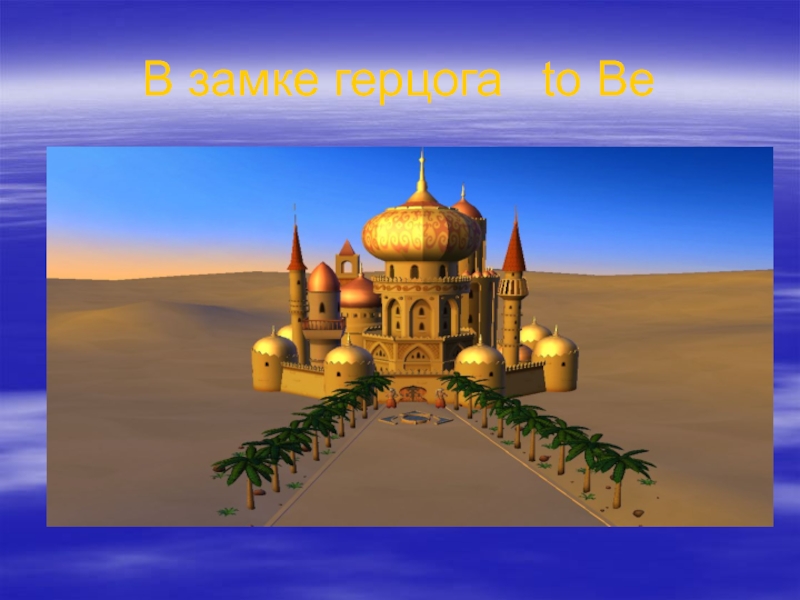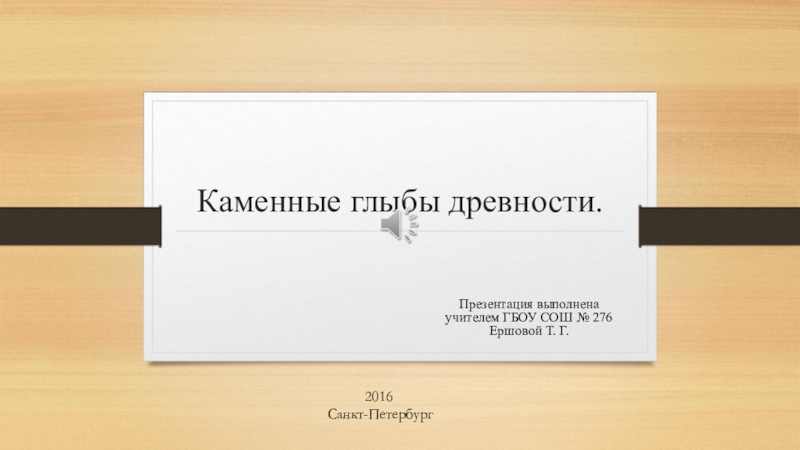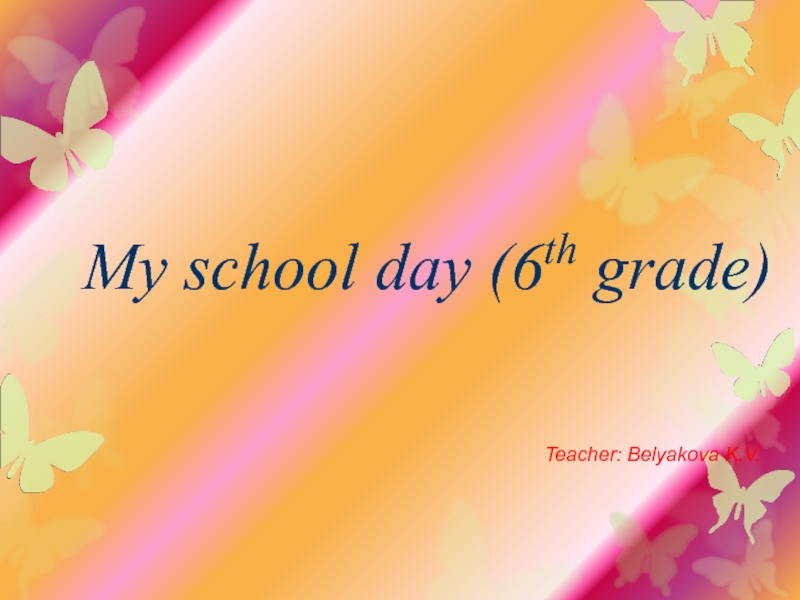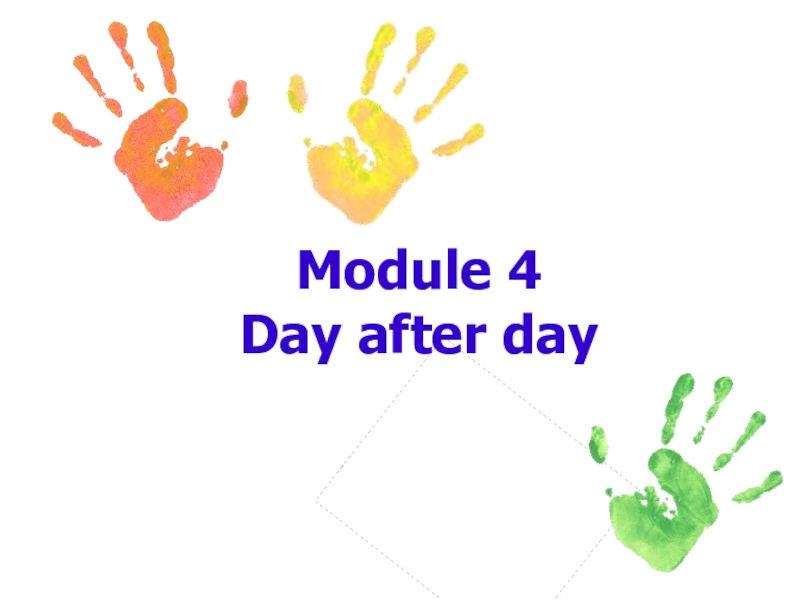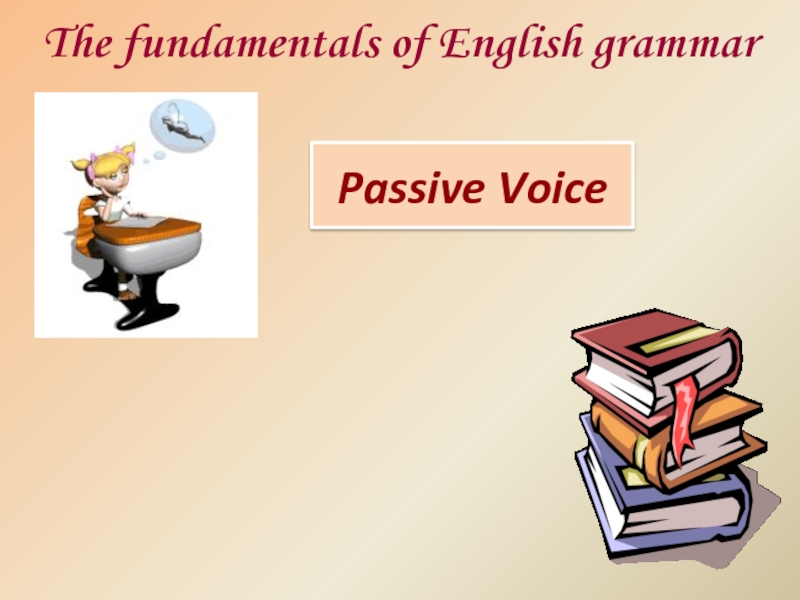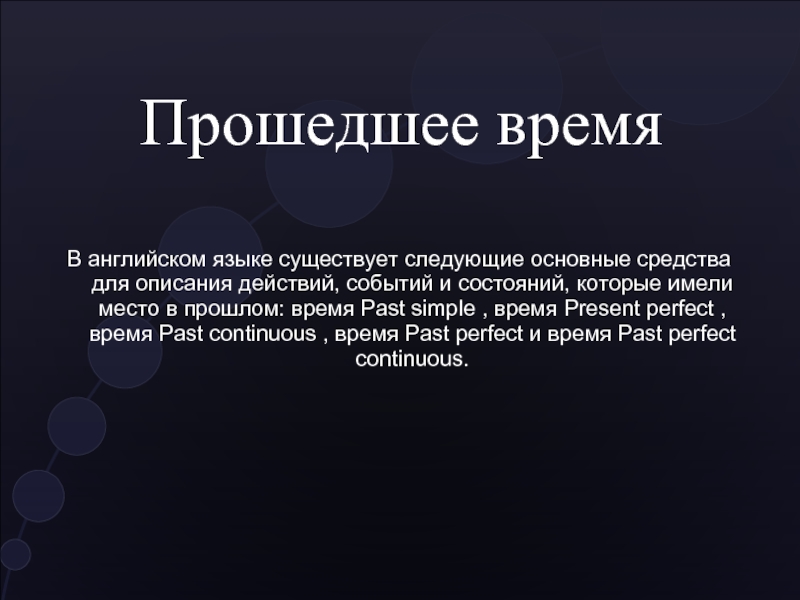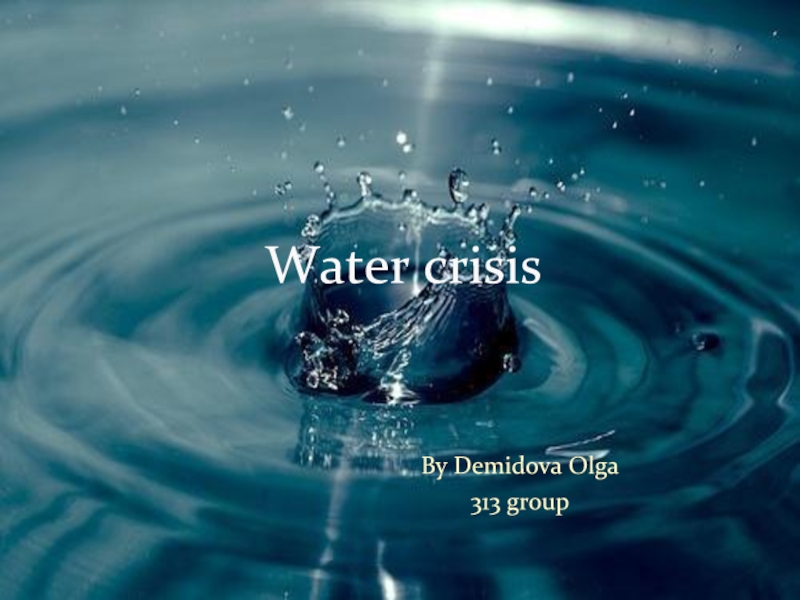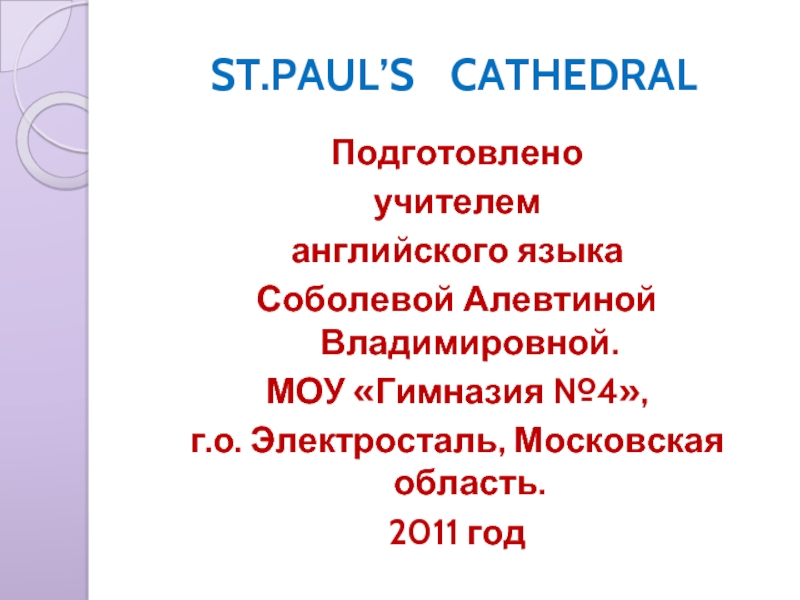Слайд 1Charlotte Brontë
& Emily Brontë
Слайд 2Charlotte,1816-1855
Emily,1818-1848
Anne,1820-1849
Слайд 3A brief biography (1)
They were born in Yorkshire. In 1820
Mr. Brontë moved his family to Haworth, a remote and
gloomy village on the Yorkshire moors. During the following years at Haworth, they had a great deal of freedom to explore the surrounding countryside. After 1831 Charlotte went to Roe Head and worked there intermittently. In 1842 their aunt provided them with money to go to Brussels to study French.
All the Brontë scribbled poetry secretly. In 1846 they published their first and only poetry Poems by the authors named Currer, Ellis and Acton Bell (the pseudonyms they choose preserved their own initials). However, their poetry proved failure which led all three to begin work on novels.
Слайд 4A brief biography (2)
Emily and Anne had been more successful
than Charlotte in getting their first novels accepted while their
works were published under the sisters’ pseudonyms.
In 1848 Charlotte and Anne visited their publishers in London, and revealed the true identities of the "Bells." In the same year Branwell, by now an alcoholic and a drug addict, died, and Emily died shortly thereafter. Anne died the following year.
In 1854 Charlotte married her father’s curate and after a few months of marriage a cold which she caught during pregnancy brought about her death.
Слайд 7Brontë sisters’ novels
Charlotte:
Jane Eyre (1847,by Currer Bell)
Shirley (1849, by
Currer Bell
Villette (1853,
The Professor: A Tale (1857, her first written
but last published,
Emily:
Wuthering Heights (1847)
Anne:
Agnes Grey (1847)
The Tenant of Wildfell Hall (1848)
Слайд 9Jane Eyre
Jane Eyre, taking the form of autobiographies written by
authoritative and reliable narrators tells a story of a child’s
development and maturation. Its popularity and success owns much to its exceptional emotional power. Deep inside Jane we discover Charlotte’s soul.
It is a work of critical realism as well as the first and one of the most popular works of the working middle- class women.
It is the first governess novel in the history of English literature.
Слайд 10Point of view in Jane Eyre
Jane Eyre is written in
the first person (“I”) which functions as follows:
1/ indicates the
characteristic of autobiography
2/ be favorable to reveal intense, fierce and sharp feelings directly and powerfully
3/ provides a full and complete thoughts of the whole event and the other characters from the angle of vision of the narrator
4/ makes the work consistent and tends to give authority and credibility to the narrative.
Слайд 11The use of verb, adjective and adverb reinforces the strength
of emotions. It makes the sentence more intense and reflects
the sharp anguish and inner struggles of the characters. While reading, we can’t help temporarily identifying ourselves with the characters. It proves especially in Jane’s declaration.
The following are two examples selected from chapter 23, Jane Eyre:
Слайд 12I grieve to leave Thornfield: I love Thornfield: I love it,
because I have lived in it a full and delightful
life, momentarily at least. I have not been trampled on. I have not been petrified. I have not been buried with inferior minds, and excluded from every glimpse of communion with what is bright and energetic and high. I have talked, face to face, with what I reverence, with what I delight in, with an original, a vigorous, an expanded mind. I have known you, Mr. Rochester; and it strikes me with terror and anguish to feel I absolutely must be torn from you for ever. I see the necessity of departure; and it is like looking on the necessity of death."
Слайд 13‘I tell you I must go!’ I retorted, roused to
something like passion. ‘Do you think I can stay to
become nothing to you? Do you think I am an automaton?-a machine without feelings? and can bear to have my morsel of bread snatched from my lips, and my drop of living water dashed from my cup? Do you think, because I am poor, obscure, plain, and little, I am soulless and heartless? You think wrong!——I have as much soul as you-and full as much heart! And if God had gifted me with some beauty and much wealth, I should have made it as hard for you to leave me, as it is now for me to leave you. I am not talking to you now through the medium of custom, conventionalities, nor even of mortal flesh: it is my sprit that addresses your spirit; just as if both had passed through the grave, and we stood at God’s feet, equal----as we are! ’
Слайд 14The writing style of Jane Eyre
1. the rich nature images
which help establish the characters’ lives and build their personalities.
2. the framework of fair tale such as Cinderella (a heroine who is ill- treated by her stepmother but gets married to a prince later).
3. various rhetorical devices and writing skills such as hint, simile, metaphor, metonymy, symbol and so on.
Слайд 15Thornfield: thorn+ field. It is an image in Bible which
alludes to Jane’s suffering from the unfair life and resisting
the temptation from the outside world.
Love is a religion in Jane Eyre.
Слайд 17Jane Eyre’s development
There are five distinct stages of development, each
linked to a particular place: Jane’s childhood at Gateshead, her
education at the Lowood School, her time as Adele’s governess at Thornfield, her time with the Rivers family at Moor House, and her reunion with and marriage to Rochester at Ferndean.
Слайд 19Jane Eyre (1)
Jane is an orphan who grows up lonely
without nobody caring for her.
Jane is a small, plain and
poor governess of Victorian era instead of the rich, gentle, frail, modest and virtuous beauties of the conventional heroine.
Jane only has an intense feeling, a ready sympathy and a strong sense of equality and independence.
Слайд 20Jane Eyre (2)
Most importantly, Jane dares to love her master
and marries him openly in defiance of the social convention
and prejudices. It makes her as an entirely new woman in the era of Victorian.
Jane is a spirited and intelligent woman to accept her appointed place in society with unusual frankness and with a passionate sense of the dignity and needs of her sex.
Слайд 21Conflicts and struggles in Jane Eyre
The outer conflicts between Jane
and others:
Appearance, status, wealth, education and so on
The inner struggles
in Jane:
Reason and emotion
Reality and imagination
Her dependent position and her desire for independence
Her actual inferiority and spiritual superiority
Слайд 22Charlotte’s features of her novels
1. presents a vivid realistic picture
of the English society.
2. shows as intense love for the
beauty of nature.
3. Greatly influenced by Byron and Scott, her novels are all about lonely and neglected young women with a fierce longing for life and love.
4. Charlotte is exceptionally good at landscape painting and presentation of atmospheres of mystery, horror and prophesy.
5. Charlotte is known as a great impressionistic verbal painter.
Слайд 24Wuthering Heights
It is one of the most intense novels written
in the English language.
It is a story of doomed love
and revenge.
The protagonists are characterized as figures of violent emotions and typical Yorkshire characters.
The Gothic tradition and transcending including its sophisticated observation and artistic subtlety.
Слайд 25The gothic novel
The Gothic novel is a literary genre, in
which the prominent features are mystery, doom, decay, old buildings
with ghosts in them, madness, hereditary curses and so on.
Слайд 27Features of this novel
1. There is the combination of extremely
simple language with the most mighty and intensified effects.
2. Its
confusing narrative forms and narrators. The first person and the third person.
3. The apparent absence of social mortality.
Слайд 28Narrator or narrators?
Lockwood, a newcomer to the locale of Wuthering
Heights, narrates the entire novel as an entry in his
diary. The story that Lockwood records is told to him by Nelly, a servant, and Lockwood writes most of the narrative in her voice, describing how she told it to him. Some parts of Nelly’s story are narrated by other characters.
Слайд 29Some questions
1. What’s the meaning of “intense”?
2. What makes love
doomed?
3. What do you think the revenge in this novel?
4.
What’s the point of the “moors”?
5. Why does the author mention “ghosts” sometimes?
6. What’s the theme of this novel?
Слайд 30moors
The landscape in the novel is comprised primarily of moors:
wide, wild expanses, high but somewhat soggy, and thus infertile.
The moors serve very well as symbols of the wild threat posed by nature. As the setting for the beginnings of Catherine and Heathcliff’s bond (the two play on the moors during childhood), the moorland transfers its symbolic associations onto the love affair.
Слайд 31ghosts
Ghosts appear throughout Wuthering Heights, as they do in most
other works of Gothic fiction, yet Brontë always presents them
in such a way that whether they really exist remains ambiguous. Thus the world of the novel can always be interpreted as a realistic one. Certain ghosts—such as Catherine’s spirit when it appears to Lockwood in Chapter III—may be explained as nightmares. The villagers’ alleged sightings of Heathcliff’s ghost in Chapter XXXIV could be dismissed as unverified superstition. Whether or not the ghosts are “real,” they symbolize the manifestation of the past within the present, and the way memory stays with people, permeating day-to-day lives.
